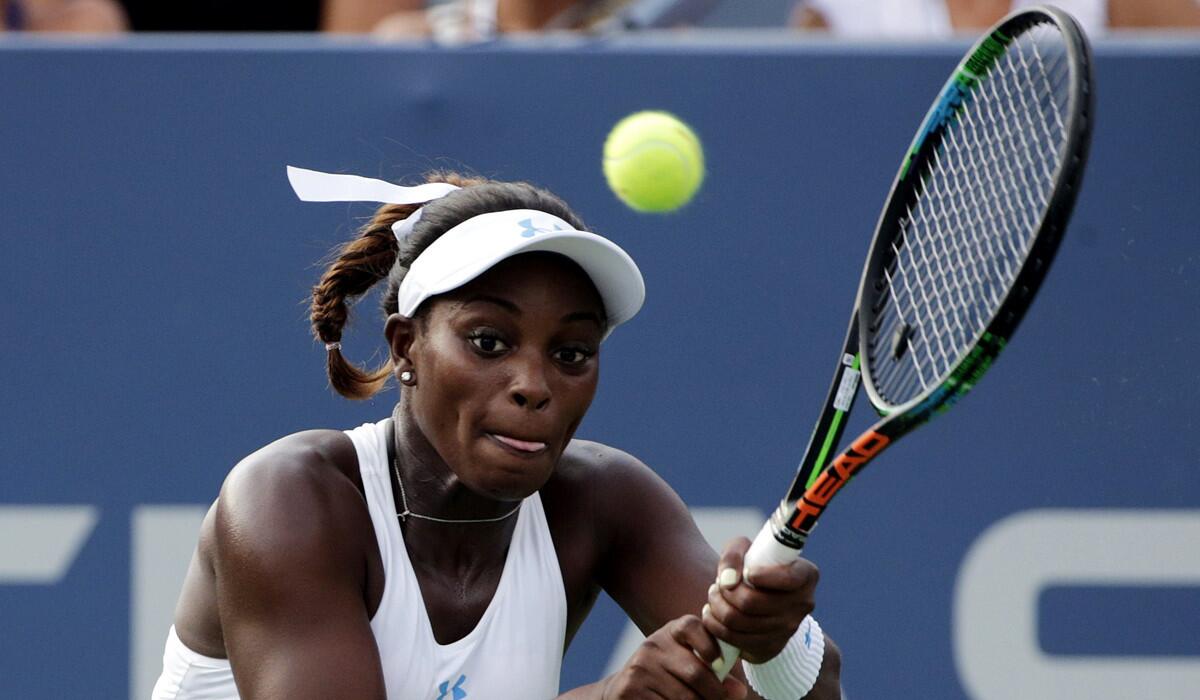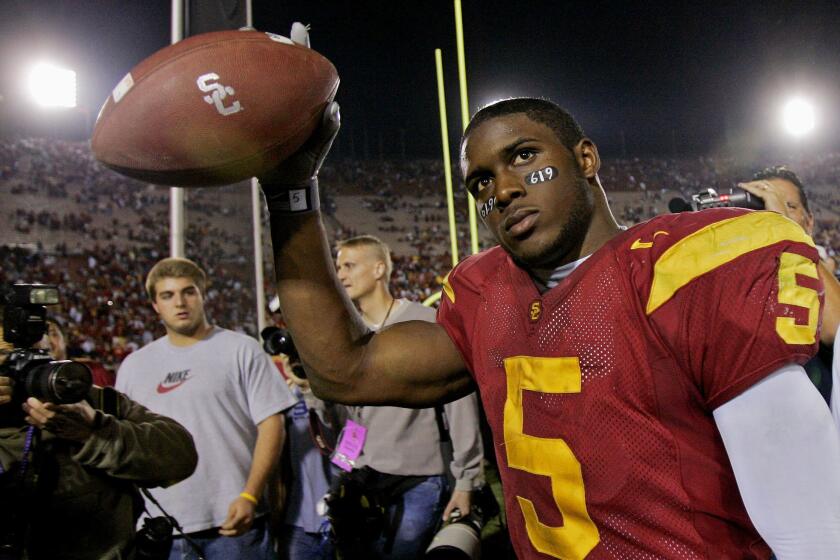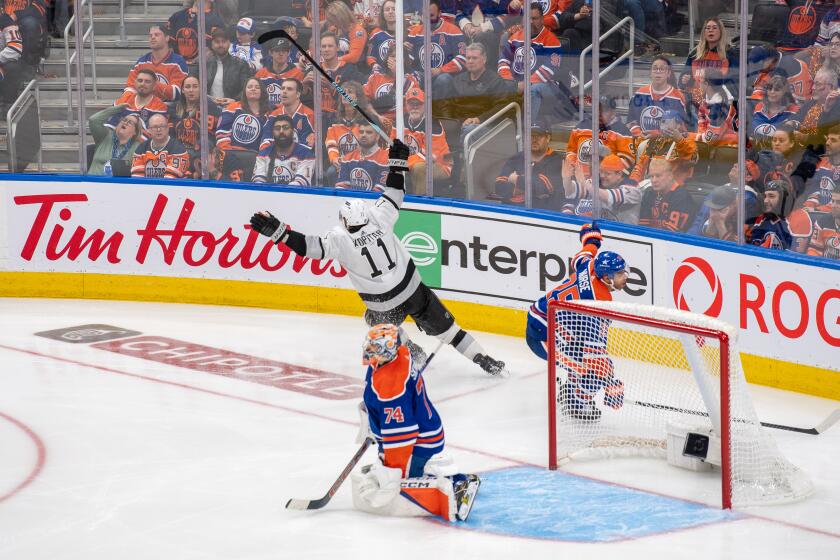ESPN crosses a line at U.S. Open with mid-match tennis player interviews

Sloane Stephens returns a shot to Coco Vandeweghe during the first round of the U.S. Open tennis tournament on Monday.
This will happen in your lifetime. Make book on it.
Mike Trout will be facing Clayton Kershaw with the score tied in the ninth inning of Game 7 of the World Series. Two on, two out, 3-and-2 count.
ESPN’s Tom Rinaldi will stroll onto the field, the umpire will throw up his hands for a timeout, and Rinaldi will put a microphone under Trout’s chin and ask: “How do you feel right now, Mike?”
You will lean forward in your easy chair, eyes wide open, and silently root for Trout to do to Rinaldi what Juan Marichal once did to John Roseboro.
It’s coming, fans. Deal with it or take the TV set out to the garage and pile 20 Christmas boxes on it.
ESPN, the worldwide leader in making sure they tell you every day they are the worldwide leader, went all in here at the U.S. Open on Monday. Between sets of her 6-4, 6-3 victory over Sloane Stephens, CoCo Vandeweghe allowed ESPN’s Pam Shriver to sit down next to her and ask her questions. Yes, mid-match.
Shriver asked: “What were you most happy with in the first set?” And, “What do you need to do in the second set to close out the win?”
Because it was Shriver, sensitive and bright, the exchange was measured. But the line had been crossed. And with the current era we live in, driven by an insatiable quest for anything new — whether or not the new makes any sense — we shall never go back.
Chris Evert, who also works for ESPN — doesn’t the entire media world now? — said at a morning news conference, “We hope to do it every day.”
The quick background is as follows: ESPN this year has added the telecast rights to the entire U.S. Open to its scorched-earth business approach: Pay somewhere around $800 million and you got it. Own it all and control it all. There is sports reporting and there is paid journalism. This is the latter, and has been for some time.
If a reporter from your local newspaper/website walked onto the court in mid-match and sat down next to Vandeweghe, she’d scream for security and the old ink-stained wretch would be filing his story from cell block 10.
In fairness, Vandeweghe had advance warning. Shriver talked to her and gave her the option of saying no right up to the moment they turned on the mic. But Shriver, being Shriver, knew very well that Vandeweghe, coming from a sports-friendly and media-savvy family, would be a more likely pioneer than most others.
It was such a meaningful experience for the young player from San Diego that after the match she said of the interview, “I don’t remember a thing I said.”
Didn’t matter. The beehive had been stirred.
Fellow player Caroline Wozniacki tweeted, “Did I just see CoCo do an interview on court, mid match, after the first set?? Surely you would want to focus on the game out there, no?”
Serena Williams, women’s No. 1, was bemused at the thought and said, “Hopefully, they don’t make that mandatory.”
Novak Djokovic, men’s No. 1, ever the diplomat, said when asked if he’d submit to this, “I will not, definitely, in this tournament. But who knows? Who knows what the future brings?”
Evert, along with ESPN executives Scott Guglielmino and Jamie Reynolds, said that they considered this to be “an evolution, not a revolution.” They said this is not a new concept, that baseball managers do it mid-game from the dugout, that viewers can tap into Phil Mickelson and his caddy, Jim “Bones” MacKay, as they ponder a shot, that LeBron James is occasionally miked during NBA games. NASCAR drivers chat at 100-plus mph.
Ah, but several wrongs do not make a right.
Is ESPN telecasting competition or branding ESPN? Is there not a time coming when viewers, who just want to see the sport without all the noise and gimmicks and announcer yakking, will revolt and start clicking that off button in disgust?
Probably not.
As Evert said, “This is a new age.”
Never again in your lifetime will you experience anything like the late and venerable Ray Scott’s description of a spine-tingling moment in a Packers game as follows: “Starr . . . Dowler . . . touchdown.”
There will be little future for the norm of Vin Scully and Al Michaels, uttering several words of magic and letting the picture and crowd noise properly carry the moment.
This year, ESPN is doing 1,100 hours of U.S. Open telecasting, in one form or another on its various channels and platforms. It is in the first year of an 11-year contract with the United States Tennis Assn., which is a partner in this on-court interview experiment.
Both say the experiment is an attempt to be innovative on behalf of the sport, to bring viewers closer to the players. “For the good of the sport” is always an admirable crutch. Also easy.
Two things could throw cold water on this: 1. The players revolt, which they won’t, because they cherish their paychecks, as we all do; 2. Viewers switch channels in numbers large enough to affect ratings, which they won’t, because they want the sports ESPN has, which is most of them, and they can’t get them anywhere else.
Big money wins. It always wins.
It’s this simple. The game is not what matters anymore. It is the presentation of the game. The marketing and branding come first. Then, later, maybe, a final score.
So brace yourself. It is 2017. Arthur Ashe Stadium. Fifth set. Break point for Roger Federer. Nineteenth major title at stake. Temperature is 90 degrees, with 75% humidity. He is trying not to cramp.
Here comes Rinaldi: “How you feeling, Roger?”
Twitter: @DwyreLATimes
More to Read
Get our high school sports newsletter
Prep Rally is devoted to the SoCal high school sports experience, bringing you scores, stories and a behind-the-scenes look at what makes prep sports so popular.
You may occasionally receive promotional content from the Los Angeles Times.







